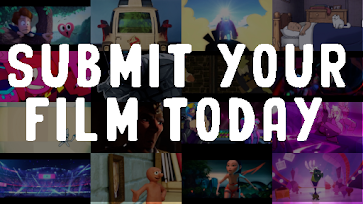Interview with John Dilworth "Goose in High Heels"
Classic cartoon fans may recall, in the mid-1990's a particular short film premiered on the Cartoon Network's What a Cartoon program by the name of “The Chicken from Outer Space” An animated short about a small farmhouse in the middle of nowhere protected by a small and somewhat cowardly dog. The short was strange and dark but ultimately it was the heart at the center of the story that endeared us to this little dog. Enough that when that same dog got his own animated series, fans were ecstatic.
The series creator, John R. Dilworth, continues to be a prolific animator and creative voice in the cartoon community. Developing numerous independently funded animated short films under the banner of his production company, Stretch Films. Shorts that dare to be grim, silly, and endearing all at the same time.
A new short film, titled “Goose in High Heels” is well on its way to release.
Synopsis: A tale told in three intertwined stories focused on a writer driven by glory. He struggles to complete a masterpiece, with inspiration from a life-long muse, about love, betrayal and horror based on childhood memories. After an encounter with an unnatural force, the writer realizes his true prize.
Though the animation in this short is not as consistent or polished as some of Dilworth's previous short films, like the "The Dirty Birdy" or the "Mousochist", "Goose in High Heels" still feels like it belongs in among some of Dilworths' best. The visual comedy is fast paced and doesn't let up. Leading from one great gag to the next. Also, much like “Chicken from Outer Space” there is a greater emphasis on telling a complete story. Each of the subsequent stories is all connected to the writer himself as he struggles to complete his work. The transitions do a good job to illustrate how each of these stories connects so during a scene change, so the following proceedings don't feel out of place.
"Goose in High Heels" in terms of tone is very silly and it revels in it, much to the short's benefit. Instead of dialogue, the characters speak a gibberish babble but the audience is given visual cues as to what is being said. The animation itself has a great deal of energy in it which helps the jokes stick and quite a few recurring visuals from Dilworth's previous work (Exaggerated teeth when the characters smile, the slow eye blink, and the occasional dose of dark humor).
AFA had an opportunity to ask Dilworth a few questions regarding his new short.
AFA: When did you first get the idea for this short?
D - Over a period of several years. I was keeping a small sketchbook that was in HD size and I filled it up. Later I tore out all the pages and reassembled them into various stories that all connected to a writer.
AFA: Was there anyone who helped with previous Stretch Films shorts that assisted with this one?
D - The art director Margaret Frey who worked on all my early shorts including The Dirty Birdy and The Chicken from Outer Space, my MTV pilots and she did the opening titles for Courage the Cowardly Dog. The musicians Jody Gray and Andy Ezrin created the music. They work with Jon Smith, This team created the music for most of my shorts starting with Noodle & Nedd back in 1996. Pilar Newton was on our Courage team. William Hohauser has worked on virtually every short I've produced starting with "The Chicken from Outer Space" and co-producing "Bunny Bashing". He was also a vital collaborator on the Courage series. I think he is a natural merry-maker who would be welcome as one of the Marx bros.
AFA: There are a lot of great nods to how challenging writing a story can be, can you describe one of your own challenges when writing a story for animation?
D - I feel fortunate to be able to know how I want my story to end. In GIHH, it was vital to me that love prevailed over the pursuit of prestige or fame or reward. I feel more confident when I have something to look forward to, and an ending provides that.
AFA: Conversely, was there any jokes or moments in the story that you knew you wanted from the get-go?
D - Yes, Tex Avery tributes unveil themselves in the sequence when the muse interrupts the writer in his den. He is feeling frustrated with the process and she knows this. Like a good muse she helps him relax later turning herself into a Hokusai wave. I used the long in-between from "The Dover Boys" and a transition I discovered from a Betty Boop cartoon from the 30's... I have many tributes in the film. My muse is wearing the same outfit from Tex's Red Hot Riding Hood, for another example.
AFA: One of your many trademarks in your short films is not just the exaggeration of motion, but that at least one character is voiced by you or you provide a specific sound effect. Which character did you voice in “Goose in High Heels, if any?
D - I voiced the writer, one of the goose boys and the goose dad. William Hohauser voiced the publisher, the mom goose, and the other goose boy. We had a terrific time recording the goose voices. We vocalized through a long tube to get a specific quack frequency. I made a few YouTube process videos of the making of GIHH which could be found on Stretch Films YouTube channel.
AFA: In your synopsis of the short, it states all of the emotions focused on the story are tied to childhood memories. Can you explain what you mean by this?
D - The writer mines his childhood memories for moments of inspiration. He recalls when he first kissed a girl after witnessing his own parents. He recalls getting bullied and humiliated and ultimately turning into a bully himself. He recalls asking his father for money to buy a girl an ice cream and later when that adventure fails, he finds comfort in his mother's embrace. I intended the memories of the writer as a boy to be trans-dimensional. The writer is the boy, it is not his son. The scenes when the two interact are the writer's memory of him and his father who the writer becomes, just as the writer as boy imagines his mother embracing him, not the muse. The muse is a representational being, much like in our dreams different people play the role of ones we know. Another helpful clue is the little girl in the writer's boyhood memories is the muse. I gave them both the same hair color. The writer and his muse have known each other their entire lives.
AFA: As far as the animation goes, there seems to be a disconnect between the first half and second half (the former seemed less polished than the latter which was full of energy) Is there a reason for this?
D - The animation process took two years to complete. I began drawing directly on a Wacom Cintiq using the proletariat software Flash. I had never made a movie this way As anyone who works with Flash knows, the line that appears on the screen is not one line, it is a collaborative line between the artist and the software. I elected to use the line as it appeared as part of the natural and evolutionary process.
AFA: You've never been someone to shy away from the occasional grim visuals in animation, and "A Goose in High Heels" has some pretty shocking moments. Any stories as to how you came up with these dark gags/turns when working on the short film?
D - When the Fukushima reactors in Japan detonated I knew the world as it once was is done. The amounts of man-made radioactivity in the ecosystem is unprecedented and there isn't anything to be done about it. I wanted to brand the event in my movie. It is the event of our lifetime and I wanted my art to express that. I used the actual footage of the three recorded reactors detonating as well as a model of the initial dispersement of one radioactive plume and rotoscoped those events. I intended to make that the trauma moment for the writer. Each day we learn how someone steps off the curb, crossing the street and they get hit by a truck or bike and their lives change. Life happens in real time, not by convenience.
AFA: The tagline for your website for Stretch Films is, “Where it's Safe to be Silly!” Would you mind explaining why you chose this particular statement and how it reflects your work?
D - I am a long admirer of spontaneous, finite play. Children are silly and enjoy expressing themselves in a natural intuitive way. As adults, we lose this sense of sub-conscious play by our narrow belief systems and ritual behavior habits.
AFA: For readers who are excited to see “Goose in High Heels” for themselves, can you drop any hints as to when it will be available for the public to watch?
D - Please check my Facebook page or my website which is soon to be upgraded! Hahaha. Welcome to modern times, Dilly!
Sincere thanks to John Dilworth for taking the time to talk to us about his new short film!
Be sure to check out the Stretch Films website for more information on upcoming shorts!
























